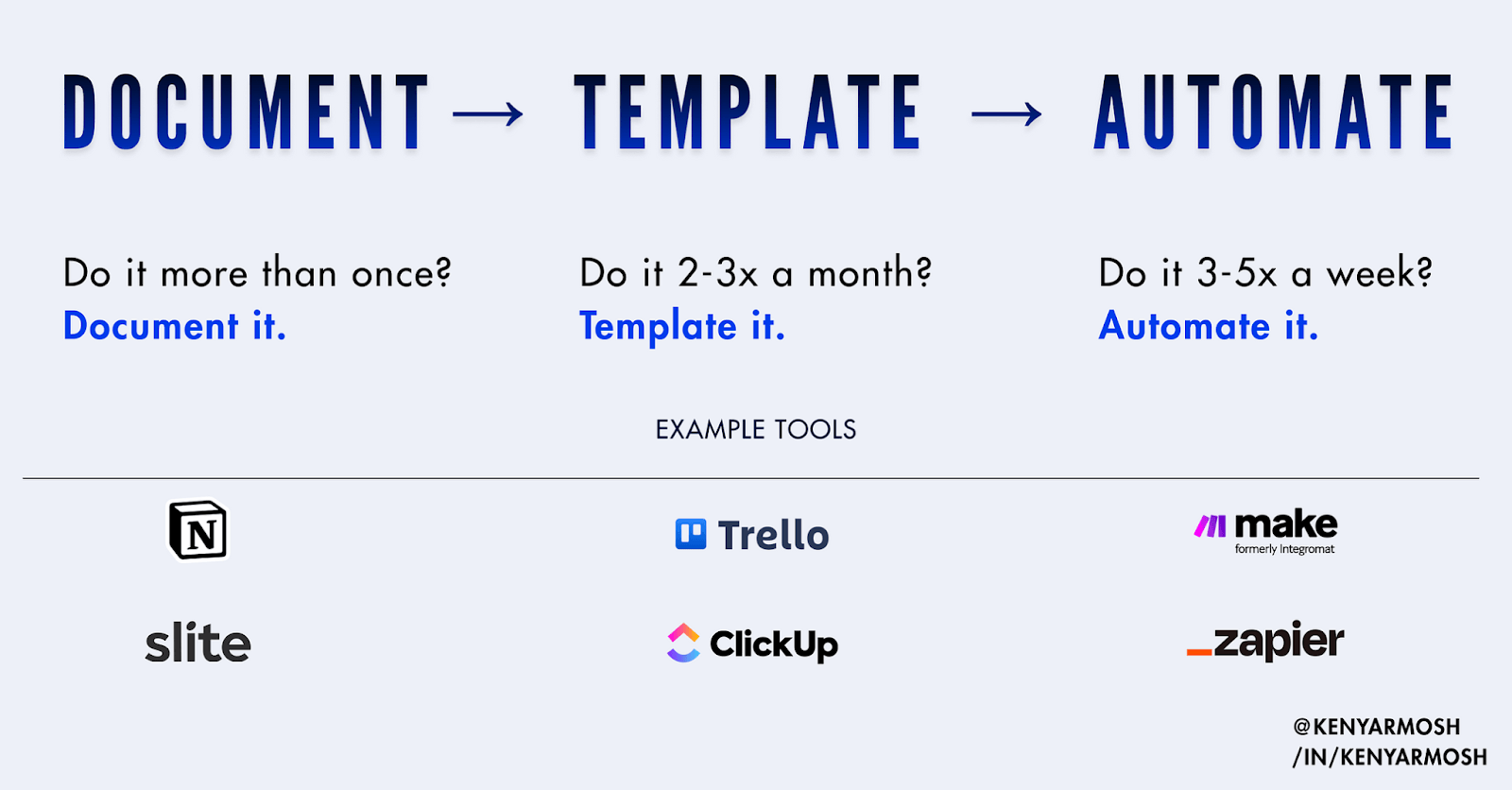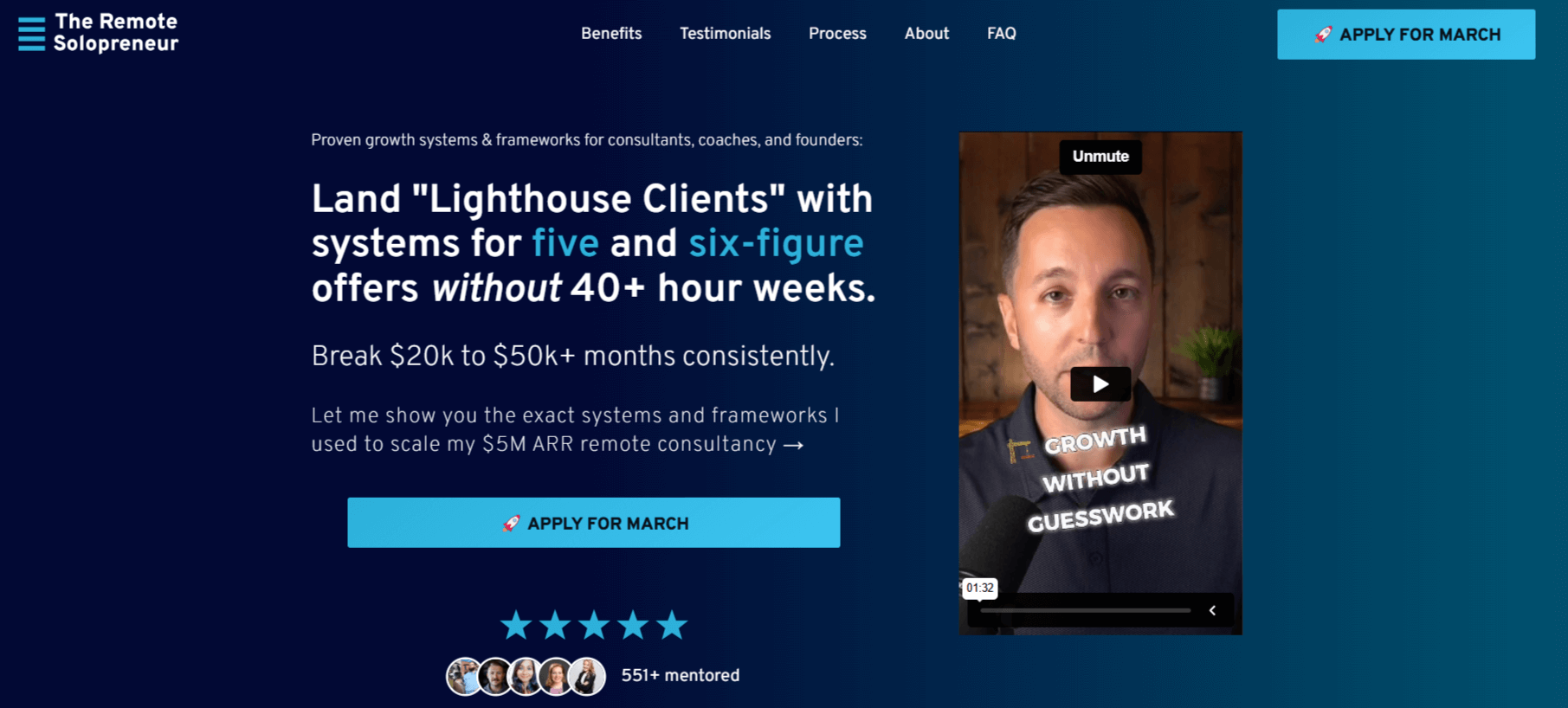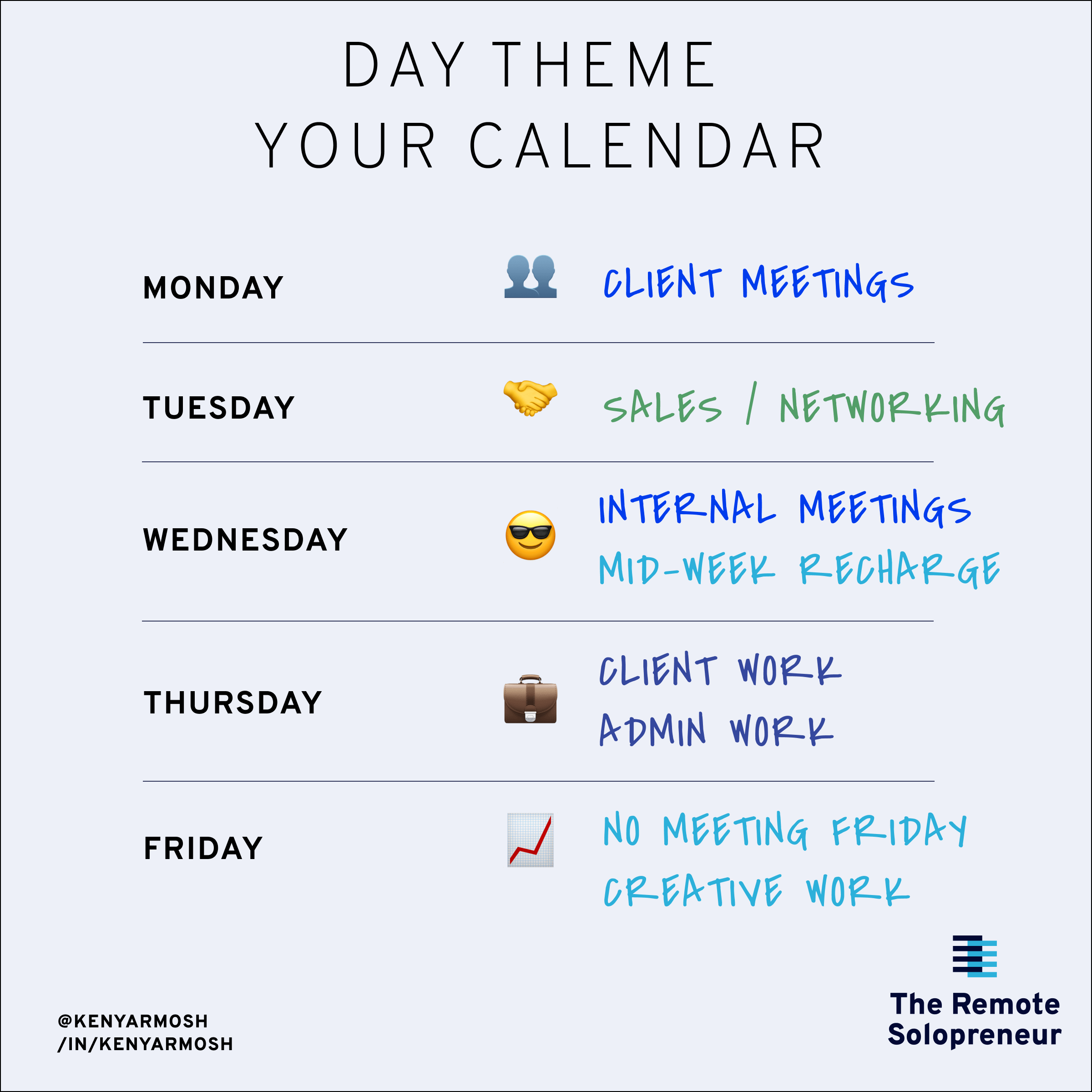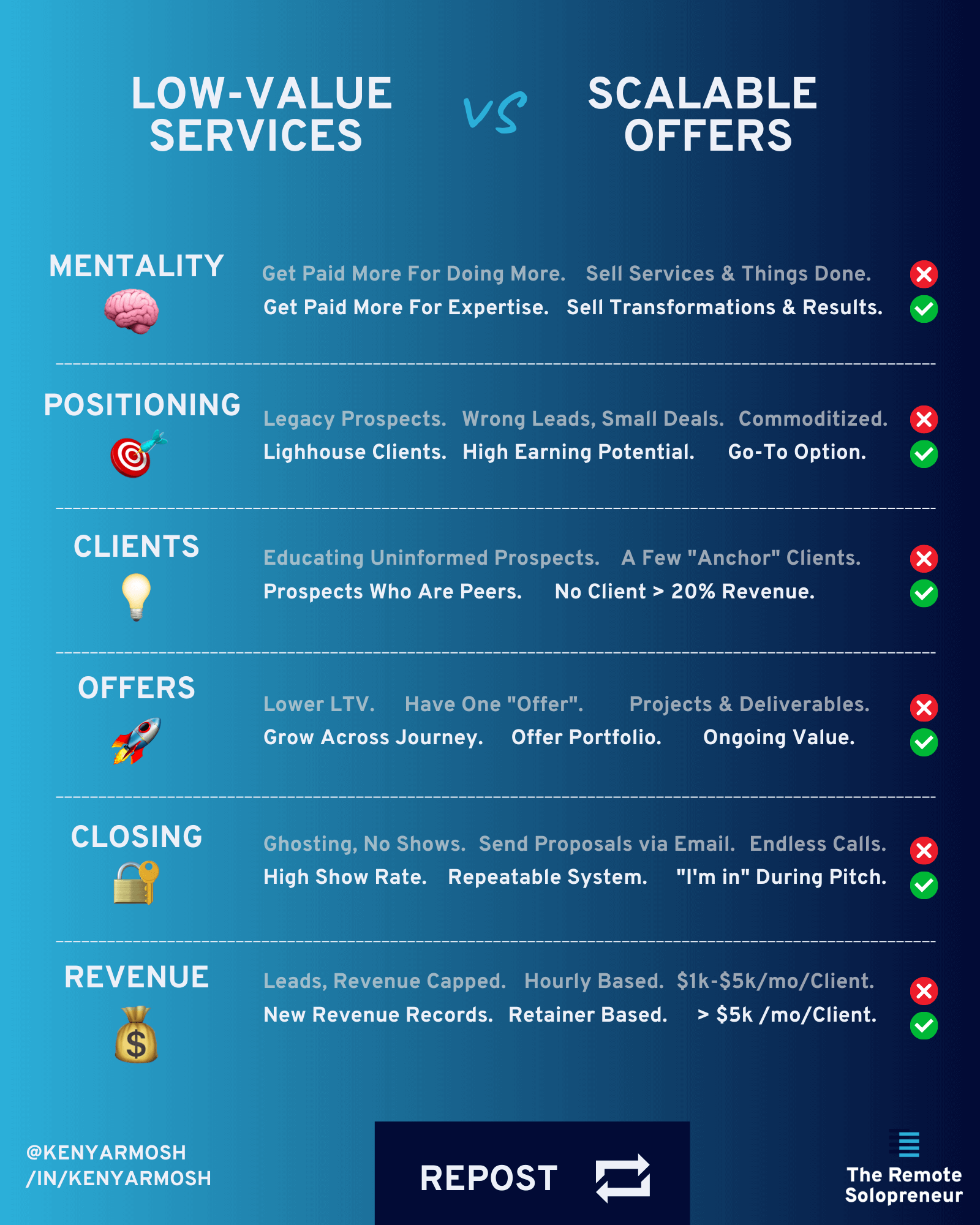🚀 TL;DR
- Scaling as a solopreneur means creating leverage with systems, automation, and reusable assets rather than hiring a big team.
- Growth stalls when offers are too complicated, positioning is unclear, or every client request gets a “yes.”
- Streamlined services, clear boundaries, and identifying an ideal client unlock efficiency and better-fit opportunities.
- Documenting processes, turning repeat work into templates, and automating routine tasks free up time for higher-value activities.
- Tracking a handful of meaningful metrics and confronting mindset hurdles like imposter syndrome helps sustain momentum and avoid burnout.
Most freelancers and consultants hit a growth ceiling. When your calendar fills up, and client requests keep coming, conventional wisdom says it’s time to hire.
Start building that agency. Expand your operation.
But that growth path isn’t for everyone.
I’ve scaled multiple seven-figure businesses without growing headcount or following the traditional agency model. The real breakthrough happens when you stop equating growth with more people and start thinking differently about what “scale” truly means for a one-person business.
In this article, I’ll explain the challenges that come with scaling your solopreneur business and how you can fix them.
Challenge #1: Overcomplicating the offer
Too many solos stack services like a buffet. But simpler offers scale better.
The second major roadblock to scaling as a solopreneur is offering too many different services or creating overly complex packages. Many freelancers and consultants fall into this trap in an attempt to appeal to everyone or because they’re afraid to turn away potential business.
I’ve seen countless solopreneurs with service pages listing 10+ offerings—each with custom scoping, pricing, and delivery methods. Each service you offer requires the following:
- Different marketing materials
- Unique sales processes
- Separate workflows and systems
- Distinct skill sets and tools
- Custom pricing models
The more services you offer, the more mental bandwidth you consume switching between different types of work. Plus, your marketing message gets diluted when trying to be everything to everyone.
How to fix this:
The key to scaling as a solopreneur is simplifying and standardizing your offerings. Here’s how to create offers that scale:
1. Reduce your service options
Start by cutting your service menu down to your most profitable and enjoyable offerings. For most solopreneurs, the ideal number is 1-3 core services. These should be services where:
- You have proven expertise and results
- Clients see clear value
- You can deliver efficiently
- There’s consistent demand
When I scaled my business past seven figures, I focused exclusively on one primary service with two variations. This clarity allowed me to perfect my delivery systems and become known for a specific solution rather than being a generalist.
2. Create tiered offerings
Once you’ve simplified your core offering, consider creating 2-3 tiers that serve different client needs. This gives options without overcomplicating your business.
A good structure is:
- Intro: Accessible, focused solution for specific problems
- Core: Your flagship comprehensive solution
- Premium: Everything plus additional support or exclusive features
This approach allows you to serve different budget levels while maintaining operational simplicity.
3. Build a Portfolio of Offers
Instead of offering many services at once, create a clear progression path for clients. Start with a focused entry point and then provide logical next steps as clients see results. For example, start with a diagnostic or assessment. Eventually, move to your core service implementation with ongoing support.
Challenge #2: Saying yes to everything
You don’t scale by being available—you scale by being specific. Every yes dilutes your leverage.
Many solopreneurs struggle with turning down work, especially in the early stages of their business. The fear of missing out on revenue or opportunities leads them to say yes to virtually any project that comes their way.
This “yes” habit might seem like the path to growth, but it creates several barriers to scaling:
- You end up working with clients outside your ideal target market
- Projects require vastly different skill sets, preventing mastery
- Your schedule becomes unpredictable and overloaded
- You can’t develop specialized systems when every project is different
- Marketing becomes unfocused because you don’t have a clear niche
When you try to serve everyone, you serve no one particularly well. This approach traps you in a cycle of custom work that’s difficult to systematize or scale.
How to fix this:
Learning to say no strategically is, paradoxically, one of the most powerful ways to scale your business. Here’s how to cultivate this skill:
1. Define your Lighthouse Client
Create a detailed description of your LC, including:
- Industry and business size
- Specific problems they face
- Budget range
- Communication style
- Decision-making process
- Values alignment
- Buying committee
- Objections and frustrations
I call these “Lighthouse Clients” who guide your business decisions and attract similar opportunities. This profile makes it easier to recognize which opportunities align with your scaling goals.
What are Lighthouse Clients?
2. Establish clear criteria for accepting work
Develop a simple framework for evaluating potential projects. For each opportunity, ask:
- Does this client match my ideal client profile?
- Will this project use my core expertise?
- Can I deliver exceptional results within my existing systems?
- Is the budget aligned with my target pricing?
- Does this work support my long-term business direction?
If an opportunity doesn’t meet at least 4 out of 5 criteria, it distracts you from scaling.
3. Implement a “not now” list
Create a document capturing interesting ideas and opportunities that don’t align with your current focus. Reviewing this list quarterly allows you to:
- Identify patterns in what you’re saying no to
- Reevaluate opportunities when your capacity changes
- Potentially develop new offerings in the future
By saying no to projects that don’t align with your expertise and systems, you create space to say yes to the right opportunities.
Challenge #3: No clear positioning
Generic doesn’t scale. Clarity is what lets people share you, refer you, and trust you at scale.
Many solopreneurs position themselves as generalists who can help anyone with anything in their broad field. They describe themselves with vague terms like “marketing consultant,” “business coach,” or “web designer” without any specificity about who they serve or what particular problems they solve.
This generic positioning creates significant scaling challenges:
- You blend in with thousands of other service providers
- Potential clients can’t quickly determine if you’re right for them
- You attract inquiries from people who aren’t ideal fits
- Referrals become difficult because others can’t easily explain what you do
- You can’t command premium rates without specialized expertise
When you’re trying to be everything to everyone, you become forgettable to everyone.
How to fix this:
Developing clear, focused positioning is one of the highest-leverage actions you can take to scale your solopreneur business. Here’s how to approach it:
1. Identify your unique intersection
Find the sweet spot where these three elements overlap:
- Your genuine expertise and strengths
- Market needs with willing buyers
- Areas you enjoy working in
This intersection becomes the foundation of your positioning. For example, instead of being a “marketing consultant,” you might position yourself as “the email sequence specialist who helps SaaS companies improve trial-to-paid conversion rates.”
2. Niche down by client type or problem
Choose to specialize by a specific client type (industry, size, stage) or a particular problem you solve exceptionally well.
When I scaled past seven figures as a solopreneur, I focused exclusively on helping established service-based solopreneurs scale without hiring. This clarity made my marketing, sales, and delivery much more efficient than when I worked with various business types.
3. Develop a clear positioning statement
Create a simple statement that captures the following:
- Who you help (specific audience)
- What problem you solve (specific outcome)
- How you’re different (your unique approach)
For example: “I help independent financial advisors double their client acquisition through relationship-based content strategies without spending on paid ads.”
This statement should guide all your marketing and help others understand what you do.
Challenge #4: Trying to do everything manually
You’re probably familiar with this pattern: you wake up, check emails, respond to client messages, work on deliverables, schedule meetings, send invoices, update your website, and maybe squeeze in some marketing if you’re lucky.
When you do everything yourself without systems or automation, your business becomes entirely dependent on your time and energy. Your income is directly tied to the hours you work, creating a hard ceiling on your growth potential.
The reality is stark: you have 24 hours a day, and you need to sleep, eat, and hopefully have some semblance of a personal life. That leaves little time to grow your business if you handle every task manually.
How to fix this:
The solution isn’t hiring people to take over these tasks. Create systems that reduce or eliminate the need for manual intervention. Here’s how to break free from the manual work trap:
1. Document your recurring processes
Start by documenting every recurring task in your business. Client onboarding, project management, invoicing, content creation—write down your step-by-step process for each. This documentation serves two purposes: it forces you to think critically about your workflows and creates the foundation for automation.
When I work with solopreneurs, we begin with my Document → Template → Automate (DTA) framework. Document everything first—even if it feels tedious. You can’t improve what you haven’t defined.

2. Create templates for repetitive tasks
Once you’ve documented your processes, convert them into templates. These could be:
- Email templates for client communication
- Project templates in your task management tool
- Contract templates
- Reporting templates
Templates dramatically reduce the mental load of repetitive tasks while ensuring consistency in your work.
I’ve created templates for everything from sales calls to project kickoffs to client reports, saving hours every week while maintaining quality.
3. Automate what doesn’t require your unique expertise
After templating comes automation. Look at your documented processes and ask: “Which parts of this don’t need my personal touch?”
Tools like Zapier allow you to connect your business apps and automate workflows without coding knowledge.
For example, I automated my client onboarding process to send welcome emails, create project spaces, and schedule kickoff calls—all triggered by a single form submission. What used to take 90 minutes now takes 5.
Challenge #5: Dealing with imposter syndrome
When you’re building a business alone, there’s no team to validate your decisions or buffer you from market feedback.
This isolation often breeds imposter syndrome. You feel you’re not qualified enough or somehow deceiving clients by positioning yourself as an expert.
I’ve watched talented solopreneurs sabotage their growth potential because they couldn’t overcome these internal doubts.
How to fix this:
Scaling your business requires overcoming the mental barriers that keep you playing small. Here are strategies that have worked for me and the solopreneurs I coach:
1. Document your wins and client results
Create a “wins file” where you catalog positive client feedback, successful projects, and measurable results you’ve achieved. Review this regularly, especially before sales calls or when setting pricing.
When you have concrete evidence of your impact, it becomes harder to dismiss your expertise. I keep a “Wall of Love” that includes client testimonials and metrics from my projects, a powerful reminder when self-doubt creeps in.

2. Join a community of peers
Isolation amplifies imposter syndrome. Connecting with other solopreneurs who face similar challenges provides perspective and validation.
In my remote solopreneur community, members frequently share pricing strategies, mental challenges, and sales approaches. This transparency helps everyone calibrate their value more accurately against market standards.

3. Focus on client problems, not your credentials
Shift your mindset from “Am I qualified enough?” to “Can I solve this specific problem?”
During sales conversations, concentrate on deeply understanding the client’s challenges and clearly articulating how your solution addresses them.
When you position yourself as a problem-solver rather than a collection of credentials, both you and the client can focus on what truly matters—results.
Challenge #6: Being unsure of what’s working and what’s not
Most solopreneurs operate on intuition rather than data. They pursue marketing channels because they “feel right,” or continue service offerings without analyzing profitability. Sometimes, they make critical business decisions based on hunches or the latest trends they’ve read about.
You’re navigating your business blindfolded. You can’t scale what you can’t measure. When everything in your business feels important, but nothing is clearly working, you spread yourself too thin across too many initiatives.
How to fix this:
Creating clarity about what drives results in your business allows you to double down on high-leverage activities and eliminate those that waste your time. Here’s how to gain that clarity:
1. Identify your key performance indicators (KPIs)
Start by defining 3-5 metrics that truly matter for your business model. For most service-based solopreneurs, these include:
- Lead generation rate (new qualified prospects per month)
- Conversion rate (percentage of prospects who become clients)
- Average project value
- Client retention/repeat business rate
- Profit margin per project
Avoid vanity metrics like social media followers or website traffic unless you can directly tie them to revenue generation.
2. Implement simple tracking systems
You don’t need complex analytics to get started. Begin with basic tracking using tools you already have:
- Use your CRM to track lead sources and conversion rates
- Create a simple spreadsheet to monitor project profitability
- Set up basic analytics for website performance
- Use time-tracking tools to analyze how you spend your working hours
The goal is to have enough information to make better decisions than you’re making now.
3. Conduct regular business reviews
I always recommend scheduling monthly and quarterly reviews of your key metrics. During these sessions:
- Compare performance against previous periods
- Identify trends in what’s working and what isn’t
- Connect specific activities to measurable outcomes
- Make data-informed decisions about where to focus next
I regularly reflect on what’s working and not working in my business. This practice also gives me time to focus on my own business—instead of always working on a client’s business.
Challenge #7: Neglecting systems and templates
The difference between a busy freelancer and a calm solo founder is systems. Not talent.
One of the most significant differences between struggling solopreneurs and those who successfully scale is their approach to systems and processes. Many talented professionals operate from scratch each time they tackle a task, reinventing the wheel with every new client or project.
When you don’t have documented systems and reusable templates, you’re rebuilding your business repeatedly from the ground up. This approach creates several scaling problems:
- You waste time and energy recreating similar deliverables
- Quality becomes inconsistent across projects
- Onboarding new clients takes longer than necessary
- You can’t quickly analyze and improve your processes
- Your business becomes entirely dependent on your memory and preferences
This lack of systematization creates an artificial ceiling on your growth. No matter how skilled you are, you’ll hit capacity limits much sooner without proper systems.
How to fix this:
Systems are the secret weapon of successful solopreneurs. Here’s how to build them effectively:
1. Start with your highest-volume processes
Begin systematizing the workflows you use most frequently. These typically include:
- Client onboarding and offboarding
- Sales and proposal processes
- Project kickoffs and management
- Content creation and delivery
- Reporting and client communications
For each process, document the current steps you take from start to finish. Don’t worry about perfection—capture your current approach first, then refine it.
2. Create templated deliverables
Identify the deliverables you create repeatedly and develop templates for each. This might include project proposals and contracts, client questionnaires, intake forms, or email responses.
These templates should be 80-90% complete, requiring only minor customization for each use case. The goal is to reduce the cognitive load of creating these assets from scratch each time.
3. Build a knowledge base and project management system
Develop a centralized repository for your business knowledge, processes, and templates. This could be as simple as a folder structure in Google Drive or as robust as a dedicated tool like Notion.
Organize your knowledge base to make information easily retrievable when needed. Include documents like templates, frameworks, client information, and standard operating procedures (SOPs).
Make them actionable using a project management tool that fits your workflow. You can set up standard templates that include:
- Common task lists for each project type
- Typical timelines and milestones
- Required deliverables
- Client touchpoints and check-ins
With these templates, you can quickly spin up new projects without the mental effort of planning from scratch each time.
Challenge #8: Confusing busyness with growth
Many solopreneurs fall into the trap of equating a packed calendar with business success. They pride themselves on being booked solid months in advance, working long hours, and juggling multiple client projects.
While being in demand is undoubtedly better than the alternative, confusing busyness with actual business growth creates several problems:
- You have no time to work on strategic improvements to your business
- Your income remains capped by your available hours
- Quality can suffer when you’re constantly rushing
- You have no capacity to pursue unexpected opportunities
- Burnout becomes almost inevitable
Being busy can give the illusion of progress while keeping you stuck in place.
I’ve worked with numerous solopreneurs working 60+ hours weekly but plateaued in revenue and impact because they had no time to improve their business model or delivery systems.
How to fix this:
Shifting your focus from busyness to true growth requires a fundamental mindset change about how you measure success. Here’s how to make this transition:
1. Redefine your success metrics
Move beyond vanity metrics like hours worked or calendar fullness. Instead, measure:
- Revenue per client
- Profit per hour of work
- Value delivered vs. time invested
- Client results and satisfaction
- Your work-life balance and energy levels
These metrics better reflect true business health and scaling potential than simply being busy.
2. Build margin into your schedule intentionally
Reserve at least 20% of your working hours for business development and improvement. This time is non-negotiable and should be treated with the same respect as client meetings.
I use “Day Theming” to ensure dedicated time for strategic work. For example, Mondays are for internal projects and planning, while client work is concentrated on Tuesdays through Thursdays. This structure prevents client work from consuming every available hour.

3. Focus on capacity building rather than utilization
Instead of trying to maximize how fully your time is used, focus on building systems that increase your overall capacity. This includes:
- Creating templates and processes that reduce time per deliverable
- Developing intellectual property that you can reuse across clients
- Building automation that handles routine tasks
- Creating frameworks that streamline decision-making
These investments may temporarily reduce your utilization rate but dramatically increase your long-term capacity.
Challenge #9: Not building reusable assets
One of the biggest constraints on scaling as a solopreneur is creating everything from scratch for each client or project. Many service providers operate entirely in a custom, one-to-one delivery model, where each deliverable is built specifically for one client and used only once.
If everything you make is 1:1, you’re rebuilding the business every month.
This approach creates several scaling limitations:
- Your income is directly tied to your time
- You can’t leverage past work to reduce future effort
- Each new client requires the same amount of work as the first
- Your knowledge and expertise remain locked in your head
- You’re constantly reinventing solutions to similar problems
Without reusable assets, you start from zero with each new client or project. This severely limits your ability to scale beyond your personal capacity.
How to fix this:
Building a library of reusable assets is one of the most powerful ways to scale your impact and income as a solopreneur. Here’s how to approach this:
1. Inventory your recurring deliverables
Identify the work products you create repeatedly across different clients. These might include assessment frameworks, strategy documents, and implementation plans.
For each item, note how frequently you create similar versions and how long it typically takes.
2. Develop intellectual property (IP)
Create proprietary methodologies, frameworks, or systems that formalize your approach. These assets:
- Differentiate your services from competitors
- Provide structure for your service delivery
- Can be licensed or sold as standalone products
- Add perceived and actual value to your offerings
For example, my Scalable Offers framework gives solopreneurs a structured process to create a high-ticket offer for Lighthouse Clients.

3. Plan for continuous asset development
Schedule time regularly to refine and expand your asset library. After each client engagement, ask:
- What new assets did I create that could be reused?
- How can I improve existing assets based on this experience?
- What new needs did I identify that I could address with a reusable asset?
Treating asset development as an ongoing investment rather than a one-time project ensures your library continuously evolves and expands.
Challenge #10: Avoiding automation out of fear or perfectionism
Many solopreneurs resist automation because they worry about losing the personal touch that differentiates their service. Others avoid it due to perceived complexity or the time investment required.
This resistance to automation creates several scaling bottlenecks:
- Routine tasks consume hours that could be spent on high-value work
- Inconsistencies creep in when processes are performed manually
- You become the bottleneck for every client interaction
- Business operations stop when you’re unavailable
- Growth requires proportionally more of your time
You’re creating unnecessary constraints on your business’s ability to scale.
How to fix this:
You need to think about how much time and energy you’ll get back when you automate specific tasks. Here’s how to overcome resistance and implement automation effectively:
1. Start with low-risk, high-return processes
Begin by automating processes that are repetitive and predictable, low in complexity, and take too much time.
Common starting points include:
- Client onboarding emails and document generation
- Meeting scheduling and reminders
- Invoice creation and payment follow-ups
- Social media posting and content distribution
- Basic data collection and organization
These processes offer immediate time savings with minimal risk to your client experience.
2. Use the “minimum viable automation” approach
Start with the simplest version that saves you time rather than attempting to automate entire workflows at once. You can refine and expand it later.
For example, begin with automated meeting scheduling before attempting to automate your client onboarding process. This incremental approach builds your confidence and provides quick wins.
3. Maintain the human touch where it matters most
Identify the touchpoints where your attention truly adds value and keep that manual. Automate everything else.
For instance, you might automate routine progress updates but personally deliver strategy recommendations. This balanced approach preserves your unique value while eliminating unnecessary manual work.
Challenge #11: Trying to mimic startup growth models
Many solopreneurs measure their success against venture-backed startups or traditional agencies. And they attempt to replicate growth models that require significant capital and large teams.
Solopreneurs don’t need hockey stick growth. You need sustainable, compounding leverage.
This misalignment creates several problems:
- You implement strategies that require more resources than you have
- You make decisions based on how “real businesses” operate rather than what works for solopreneurs
- You measure success using metrics that don’t reflect your actual business model
- You feel constant disappointment for not achieving unrealistic growth patterns
- You sacrifice the lifestyle benefits that likely drew you to solopreneurship in the first place
When you try to operate like a different type of business, you set yourself up for frustration and missed opportunities to leverage your unique advantages as a solopreneur.
How to fix this:
Embrace models specifically designed for solo businesses so that you can grow sustainably. Here’s how to shift your approach:
1. Redefine “scale” for your solopreneur context
For solopreneurs, scaling doesn’t necessarily mean hiring employees, opening multiple locations, or pursuing exponential revenue growth.
Instead, scaling as a solopreneur typically means:
- Increasing revenue without proportionally increasing time
- Building systems that create leverage
- Developing assets that generate ongoing returns
- Creating more value for clients with the same or less effort
- Maintaining control and independence in your business
- Getting more time back in your day
This redefinition helps you focus on growth strategies that make sense for your business model.
2. Embrace the “small giant” mindset
Rather than chasing endless growth, focus on building what Bo Burlingham calls a “small giant”—a business that’s great rather than just big. This means you should prioritize excellence over expansion and build deep expertise.
As a result, you’ll build strong relationships with fewer, higher-value clients. This mindset aligns much better with the realities and advantages of solopreneurship.
3. Focus on profit margins over revenue
Solopreneurs should prioritize profitability and cash flow over top-line revenue growth. This means:
- Increasing your effective hourly rate rather than just working more hours
- Streamlining operations to reduce costs
- Focusing on high-margin services and clients
- Minimizing overhead and unnecessary expenses
- Creating pricing models that reflect value rather than time
A $200K business with 80% profit margins is far better than a $500K business with 20% margins—especially for a solopreneur.
It’s perfectly possible to scale as a solopreneur
True scaling means increasing your impact and income without proportionally growing your time and effort. Instead, it means systematizing your operations, simplifying your offerings, and developing clear positioning. As a result, you’ll create leverage that breaks the direct connection between your hours and your earnings.
Also, make sure you define what scalability truly means to you. There are no bounds to what you can achieve, but everything comes at a cost.
If you don’t define scale for yourself, the internet will do it for you—and you’ll burn out chasing someone else’s dream.

